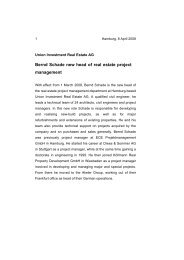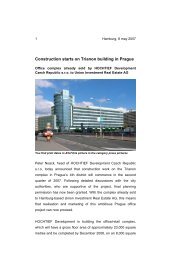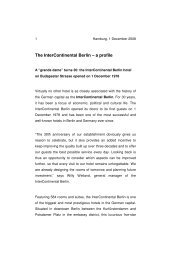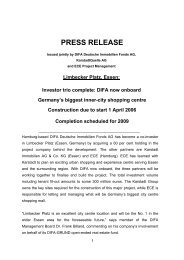BREAKTHROUGH IN THE CITY Why London's ... - Union Investment
BREAKTHROUGH IN THE CITY Why London's ... - Union Investment
BREAKTHROUGH IN THE CITY Why London's ... - Union Investment
Create successful ePaper yourself
Turn your PDF publications into a flip-book with our unique Google optimized e-Paper software.
PLACES & SPACES 20_21 PEOPLE & WORK<br />
"<strong>THE</strong> QUALITY OF<br />
EXPERIENCE <strong>IN</strong> A <strong>CITY</strong><br />
WILL DECIDE<br />
WHE<strong>THE</strong>R ITS <strong>IN</strong>NER<br />
<strong>CITY</strong> WILL DECAY OR<br />
SURVIVE <strong>THE</strong><br />
COMPETITION WITH<br />
URBAN ENTERTA<strong>IN</strong>-<br />
MENT CENTRES“<br />
Volker Eichener,<br />
scientific director<br />
of the InWIS Institute<br />
is to be retained, action must be taken by politicians, city planners<br />
– and also investors. But that’s easier said than done. After<br />
all, this means responding appropriately to irreversible processes<br />
like demographic change and also countering negative<br />
trends such as inner-city depopulation. This challenge also has a<br />
social dimension. “Urban development must try to compensate<br />
for the growing differences between rich and poor as well as<br />
young and old,” said Thalgott. One dilemma is that the partly<br />
different interests of those involved have to be reconciled. In<br />
other words, the desires and expectations of politicians, planners,<br />
architects and investors have to be reduced to a common<br />
denominator.<br />
However, the towns and cities vying for residents and jobs<br />
are usually so strapped for cash that urban development projects<br />
can’t be achieved without private-sector support. Conversely,<br />
pressure on international institutional investors to generate<br />
higher yields is intensifying. The coffers of global investors<br />
such as insurance companies, pension and investment funds<br />
are bulging – and they are on the lookout all over the world<br />
for promising property investments on behalf of their clients.<br />
Critics may complain (with some justification) about the unholy<br />
alliance between impoverished cities and powerful investors,<br />
but the challenges of the future cannot be shouldered without<br />
the “new urban developers.” “There’s no doubt that the<br />
privatisation of urban development can be observed, changing<br />
the roles of the actors,” said Thalgott. And according to<br />
Peter Wynne Rees, City Planning Officer of the Corporation of<br />
London and a world-renowned expert, “compromise is part of<br />
being an urban planner.”<br />
After all, as cities’ planning autonomy declines with their<br />
lack of cash, the influence – not to mention responsibility – of<br />
those able to jump into the breach grows. As attractive as it<br />
may seem at first sight for investors to be consulted on development<br />
master plans, “if you want to actively shape the process<br />
of urban development, you must be prepared to think ahead<br />
and shoulder the responsibility,” said DIFA board member Frank<br />
Billand. “That’s why partnership with cities is an integral part<br />
of our investment strategy.” Since 2001, the DIFA-Award has<br />
been presented for outstanding examples of inner-city districts<br />
and sustainable urban development in Europe. “There are no<br />
simple recipes,” Billand added, “rather, a variety of successful<br />
projects which could serve as an example to other cities.”<br />
CHEMNITZ’ NEW CENTRE<br />
Although the general development trends described above<br />
apply to all European cities, counteracting them remains a local<br />
task. Take the example of Chemnitz in Saxony, eastern Germany.<br />
The regional centre, which was known as Karl-Marx-Stadt<br />
while it was part of East Germany, has learned the hard way<br />
what being a “centreless city” means. The historical city centre<br />
was destroyed in an air raid in the final months of World<br />
War II in 1945, leaving a void. Reconstruction was designed<br />
to turn Chemnitz into a model socialist city. The “new social<br />
system” was to be given functional, architectural expression<br />
– a policy which allowed no room for the restoration of the<br />
old urban structures. Until the late 1980s, the city centre was<br />
mainly used by local government. “It had nothing that communicated<br />
the city’s identity to visitors, to say nothing of its<br />
inhabitants,” said Christian Pilz, head of the council’s planning<br />
department.<br />
Following German reunification, the revitalisation of the<br />
city centre became one of the priorities of urban development<br />
– and it took a good decade. The main aims were to ensure<br />
that existing cultural monuments, including the 13th-century<br />
Architectural Olympiad in Hamburg<br />
The Hamburg Architectural<br />
Olympiad has every chance<br />
of becoming a big success for<br />
the city’s urban development.<br />
Eighty architects, city planners<br />
and landscape architects are<br />
taking part in an ideas competi-<br />
tion for 10 sites of varying sizes<br />
and uses in all of Hamburg’s<br />
boroughs. The winners in the<br />
categories city planning, out-<br />
door planning and structural en-<br />
gineering will be announced at<br />
Hamburg’s City Hall in early De-<br />
cember. DIFA is one of the main<br />
sponsors of the Architectural<br />
Olympiad, and deems it a valu-<br />
able contribution to raising the<br />
quality of life in central Ham-<br />
burg and the outlying boroughs.<br />
For more information, visit:<br />
www.architekturolympiade.<br />
hamburg.de









